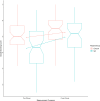United on Sunday: The effects of secular rituals on social bonding and affect
- PMID: 33503054
- PMCID: PMC7840012
- DOI: 10.1371/journal.pone.0242546
United on Sunday: The effects of secular rituals on social bonding and affect
Abstract
Religious rituals are associated with health benefits, potentially produced via social bonding. It is unknown whether secular rituals similarly increase social bonding. We conducted a field study with individuals who celebrate secular rituals at Sunday Assemblies and compared them with participants attending Christian rituals. We assessed levels of social bonding and affect before and after the rituals. Results showed the increase in social bonding taking place in secular rituals is comparable to religious rituals. We also found that both sets of rituals increased positive affect and decreased negative affect, and that the change in positive affect predicted the change in social bonding observed. Together these results suggest that secular rituals might play a similar role to religious ones in fostering feelings of social connection and boosting positive affect.
Conflict of interest statement
The authors have declared that no competing interests exist.
Figures



Similar articles
-
Blocking mu-opioid receptors inhibits social bonding in rituals.Biol Lett. 2020 Oct;16(10):20200485. doi: 10.1098/rsbl.2020.0485. Epub 2020 Oct 14. Biol Lett. 2020. PMID: 33050833 Free PMC article. Clinical Trial.
-
Health-related religious rituals of the Greek Orthodox Church: their uptake and meanings.J Nurs Manag. 2012 Dec;20(8):1058-68. doi: 10.1111/jonm.12024. J Nurs Manag. 2012. PMID: 23151108
-
Consumption rituals relating to food and drink: A review and research agenda.Appetite. 2019 Mar 1;134:86-93. doi: 10.1016/j.appet.2018.12.021. Epub 2018 Dec 17. Appetite. 2019. PMID: 30572007 Review.
-
Rituals alleviate grieving for loved ones, lovers, and lotteries.J Exp Psychol Gen. 2014 Feb;143(1):266-72. doi: 10.1037/a0031772. Epub 2013 Feb 11. J Exp Psychol Gen. 2014. PMID: 23398180
-
A sacred commitment: How rituals promote group survival.Curr Opin Psychol. 2021 Aug;40:114-120. doi: 10.1016/j.copsyc.2020.09.005. Epub 2020 Sep 16. Curr Opin Psychol. 2021. PMID: 33068836 Review.
Cited by
-
Managing the stresses of group-living in the transition to village life.Evol Hum Sci. 2022 Sep 13;4:e40. doi: 10.1017/ehs.2022.39. eCollection 2022. Evol Hum Sci. 2022. PMID: 37588930 Free PMC article.
-
Assessing Vocal Chanting as an Online Psychosocial Intervention.Front Psychol. 2021 Jun 1;12:647632. doi: 10.3389/fpsyg.2021.647632. eCollection 2021. Front Psychol. 2021. PMID: 34140914 Free PMC article.
-
Affect, Belief, and the Arts.Front Psychol. 2021 Dec 2;12:757234. doi: 10.3389/fpsyg.2021.757234. eCollection 2021. Front Psychol. 2021. PMID: 34925160 Free PMC article. Review.
-
A "random group of misfits" or being "part of something bigger"? Exploring experiences of attending a non-religious congregation.Int J Qual Stud Health Well-being. 2022 Dec;17(1):2021618. doi: 10.1080/17482631.2021.2021618. Int J Qual Stud Health Well-being. 2022. PMID: 35257631 Free PMC article.
-
A Shared Intentionality Account of Uniquely Human Social Bonding.Perspect Psychol Sci. 2025 Mar;20(2):264-275. doi: 10.1177/17456916231201795. Epub 2023 Oct 26. Perspect Psychol Sci. 2025. PMID: 37883801 Free PMC article.
References
-
- VanderWeele T.J., Religion and Health. Vol. 1 2017: Oxford University Press.
-
- Koenig H., King D., and Carson V.B., Handbook of Religion and Health. 2012: Oxford University Press.
-
- Hummer R.A., et al., Religious Involvement and U.S. Adult Mortality. Demography, 1999. 36(2): p. 273 - PubMed
Publication types
MeSH terms
LinkOut - more resources
Full Text Sources
Other Literature Sources
Medical

